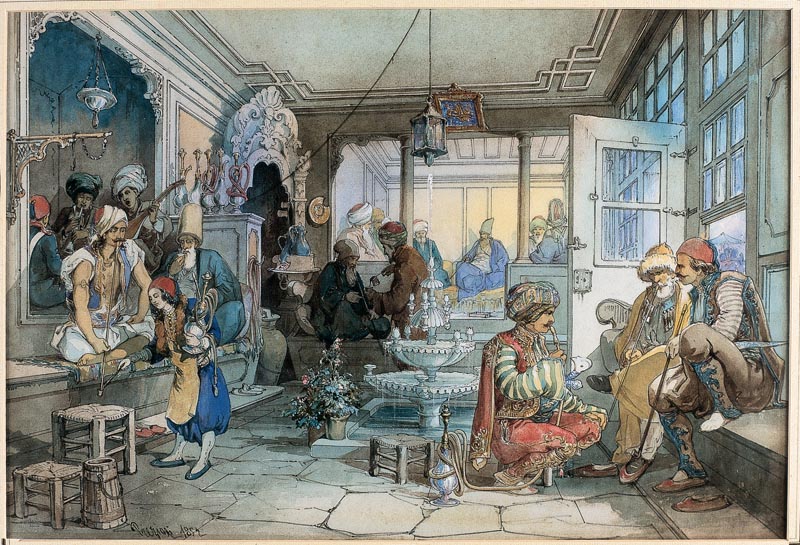Marcus has been blogging since 2009. The full archive is accessible on this site.
On Wednesday 8 December 2021, Marcus retired his beloved decade-old blog, theinkshot.com. It had served him well but its purpose and raison d’être was a little too narrowly defined to encompass current & future projects.
Below you can read more about theinkshot.com & the ideas that underpinned it.
The Ink shot was all about the culture of writing, in cafés in particular, and the struggle to pursue a life of day-to-day creativity. It was published in Melbourne Australia, a city that is home to a strong literary, coffee and gastronomic culture. Melbourne may just have the best cafes in the world. (Here is an explanation to North Americans of Melbourne coffee culture, by a US cafe chain suitably inspired to replicate the experience.)
The Ottoman example, circa 1850-1852
The emergence of the coffeehouse
The emergence of coffee drinking in the West has, in its best moments, spawned a culture of social, political and intellectual exchange and production. This was preceded by developments in the East, from where all good ideas seem to flow; the first coffeehouse appeared in what was then known as Constantinople as early as 1550. In the typically deadpan style that makes me love it so, the Encyclopedia Britannica explains that the subsequent appearance of the coffeehouse in Europe in the 17th Century gave a ‘much needed focus for the activities of the sober’.
The 17th Century English Coffeehouse
The sober (but caffeine-wired) have been flocking to the coffeehouses ever since. Coffeehouses were social spaces from the very first, the setting for all of the various acts of the human drama. They were home to political factions and plotting; exchanges of news and information; a place to buy and sell goods and even such commodities as slaves; informal post and parcel delivery points and on occasion, stages for impromptu declamation and performance. And, of course, they were a place to read and to write.
Writing habits
I don’t know about your writing habits. It may be that you are one of those fortunate and disciplined individuals who has an office set aside just for writing, and that you dutifully turn up every day at nine AM and put in a solid eight hour’s work. You may even be so lucky (if we can call it that!) as to earn your living solely from writing, and treat it much like any other job. After all, it is bloody hard work, and frequently needs the focus and concentration afforded by a dedicated writing space.
Even if these things are true, the chances are that you will not be immune to the charm of writing in an informal coffeehouse setting. You might even find it energising to write while people come and go, happily creating a curtain of white noise about you while an attentive waiter keeps you supplied with shots of the dark brown liquid. Despite the undeniable inconveniences offered by such a setting - sometimes it can just be too distracting - you might even prefer to write in such a place.
Method in the madness: A Theory
I am not sure how universal this experience is, but my personal method of writing requires that the conscious mind take a back seat. This is particularly true in the earliest stages of a written piece, or at the start of a session. Just like design, I find it essential to begin the writing act intuitively, without the left-brained control-freak parts of the brain dominating. This is easier said than done, so I have developed a slew of techniques to distract the conscious mind so the subconscious can kick in and lay a solid foundation.
Being in a café helps. With its surfeit of superficial activity, the coffeehouse provides an excellent setting for distracting the conscious mind. The constant comings and goings, the sputtering of the espresso machine, the banging of cups and plates all conspire to keep my rational faculties distracted so I can get on with the hard work of starting the work. The coffee itself is also stimulating to the nervous system; although of course, having too much is - well - too much.
Once the day’s work is underway, and I have got into flow, distracting the conscious mind matters less. In fact, it can be counterproductive. Nevertheless, it is still nice to be waited on, so even after it is strictly useful, I would typically stay ensconced in my perch, knocking back cup after cup.
The magic of the coffeehouse
Well, that’s one explanation of the attraction of the café setting for writers. Here's another, similar view, including a quote from J.K. Rowling which I have reproduced as follows:
It's no secret that the best place to write, in my opinion, is in a café. You don't have to make your own coffee, you don't have to feel like you're in solitary confinement and if you have writer's block, you can get up and walk to the next café while giving your batteries time to recharge and brain time to think. The best writing café is crowded enough to where you blend in, but not too crowded that you have to share a table with someone else.
- J.K. Rowling
Regardless of what you might think of her disappointingly well-articulated opinions of gender, sexuality and identity (to which I certainly do not subscribe), the sentiment above stands the test of time.
So while it might or might not strictly apply to you and your writing method, if you agree that the coffeehouse holds a special magic for the writer, then this is the blog for you. Here I will provide you with regular reports from the coalface of café writing in Melbourne Australia, the city I call home. We will also talk about writing and creativity, and the paraphernalia of the writer’s world. Feel free to comment; I for one look forward to our exchange.

